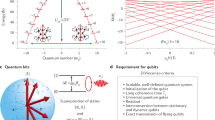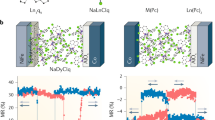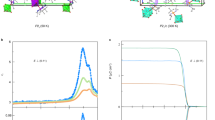Abstract
Various present and future specialized applications of magnets require monodisperse, small magnetic particles, and the discovery of molecules that can function as nanoscale magnets was an important development in this regard1,2,3. These molecules act as single-domain magnetic particles that, below their blocking temperature, exhibit magnetization hysteresis, a classical property of macroscopic magnets. Such ‘single-molecule magnets’ (SMMs)4 straddle the interface between classical and quantum mechanical behaviour because they also display quantum tunnelling of magnetization5,6 and quantum phase interference7. Quantum tunnelling of magnetization can be advantageous for some potential applications of SMMs, for example, in providing the quantum superposition of states required for quantum computing8. However, it is a disadvantage in other applications, such as information storage, where it would lead to information loss. Thus it is important to both understand and control the quantum properties of SMMs. Here we report a supramolecular SMM dimer in which antiferromagnetic coupling between the two components results in quantum behaviour different from that of the individual SMMs. Our experimental observations and theoretical analysis suggest a means of tuning the quantum tunnelling of magnetization in SMMs. This system may also prove useful for studying quantum tunnelling of relevance to mesoscopic antiferromagnets.
This is a preview of subscription content, access via your institution
Access options
Subscribe to this journal
Receive 51 print issues and online access
$199.00 per year
only $3.90 per issue
Buy this article
- Purchase on Springer Link
- Instant access to full article PDF
Prices may be subject to local taxes which are calculated during checkout




Similar content being viewed by others
References
Sessoli, R. et al. High-spin molecules: [Mn12O12(O2CR)16(H2O)4]. J. Am. Chem. Soc. 115, 1804–1816 (1993).
Sessoli, R., Gatteschi, D., Caneschi, A. & Novak, M. A. Magnetic bistability in a metal-ion cluster. Nature 365, 141–143 (1993).
Christou, G., Gatteschi, D., Hendrickson, D. N. & Sessoli, R. Single-molecule magnets. MRS Bull.. 25, 66–71 (2000).
Aubin, S. M. J. et al. Distorted MnIVMnIII3 cubane complexes as single-molecule magnets. J. Am. Chem. Soc. 118, 7746–7754 (1996).
Friedman, J. R., Sarachik, M. P., Tejada, J. & Ziolo, R. Macroscopic measurement of resonant magnetization tunnelling in high-spin molecules. Phys. Rev. Lett. 76, 3830–3833 (1996).
Thomas, L. et al. Macroscopic quantum tunneling of magnetization in a single crystal of nanomagnets. Nature 383, 145–147 (1996).
Wernsdorfer, W. & Sessoli, R. Quantum phase interference and parity effects in magnetic molecular clusters. Science 284, 133–135 (1999).
Leuenberger, M. N. & Loss, D. Quantum computing in molecular magnets. Nature 410, 789–793 (2001).
Hendrickson, D. N. et al. Photosynthetic water oxidation center: spin frustration in distorted cubane MnIVMnIII3 model complexes. J. Am. Chem. Soc. 114, 2455–2471 (1992).
Desiraju, G. R. The C–H˙˙˙O hydrogen bond: structural implications and supramolecular design. Acc. Chem. Res. 29, 441–449 (1996).
Freytag, M. & Jones, P. G. Hydrogen bonds C–H˙˙˙Cl as a structure-determining factor in the gold(I) complex bis(3-bromopyridine)gold(I) dichloroaurate(I). Chem. Commun. 277–278 (2000).
Aullón, G., Bellamy, D., Brammer, L., Bruton, E. A. & Orpen, A. G. Metal-bound chlorine often accepts hydrogen bonds. Chem. Commun. 653–654 (1998).
Raymo, F. M., Bartberger, M. D., Houk, K. N. & Stoddart, J. F. The magnitude of [C–H˙˙˙O] hydrogen bonding in molecular and supramolecular assemblies. J. Am. Chem. Soc. 123, 9264–9267 (2001).
Jeffrey, G. A. & Saenger, W. Hydrogen Bonding in Biological Structures (Springer, Berlin, 1991).
Desiraju, G. R. Crystal Engineering: the Design of Organic Solids (Elsevier, Amsterdam, 1989).
Jones, P. G. & Ahrens, B. Bis(diphenylphosphino)methane and related ligands as hydrogen bond donors. Chem. Commun. 2307–2308 (1998).
Xu, C. et al. Synthesis, molecular structures and fluxional behavior of dppm-bridged complexes of platinum(II) with linear gold(I), trigonal silver(I), or tetrahedral mercury(II) centers. Organometallics 15, 3972–3979 (1996).
Wemple, M. W., Tsai, H.-L., Folting, K., Hendrickson, D. N. & Christou, G. Distorted cubane [Mn4O3Cl]6+ complexes with arenecarboxylate ligation: crystallographic, magnetochemical and spectroscopic characterization. Inorg. Chem. 32, 2025–2031 (1993).
Carlin, R. L. Magnetochemistry (Springer, Berlin, 1986).
Wernsdorfer, W. Classical and quantum magnetization reversal studies in nanometer-sized particles and clusters. Adv. Chem. Phys. 118, 99–190 (2001).
Sangregorio, C. et al. Quantum tunnelling of the magnetization in an iron cluster nanomagnet. Phys. Rev. Lett. 78, 4645–4648 (1997).
Aubin, S. M. J. et al. Half-integer-spin, single-molecule magnet exhibiting resonant magnetization tunnelling. J. Am. Chem. Soc. 120, 839–840 (1998).
Aubin, S. M. J. et al. Resonant magnetization tunnelling in the trigonal pyramidal MnIVMnIII3 complex [Mn4O3Cl(O2CMe)3(dbm)3]. J. Am. Chem. Soc. 120, 4991–5004 (1998).
Aubin, S. M. J. et al. Resonant magnetization tunnelling in the half-integer-spin single-molecular magnet [PPh4][Mn12O12(O2CEt)16(H2O)4]. Chem. Commun. 803–804 (1998).
Boskovic, C., Pink, M., Huffman, J. C., Hendrickson, D. N. & Christou, G. Single-molecule magnets: ligand-induced core distortion and multiple Jahn–Teller isomerism in [Mn12O12(OAc)8(O2PPh2)8(H2O)4]. J. Am. Chem. Soc. 123, 9914–9915 (2001).
Andres, H. et al. Inelastic neutron scattering and magnetic susceptibilities of the single-molecule magnets [Mn4O3X(OAc)3(dbm)3 (X=Br, Cl, OAc, and F): variation of the anisotropy along the series. J. Am. Chem. Soc. 122, 12469–12477 (2000).
Barbara, B. & Chudnovsky, E. M. Macroscopic quantum tunneling in antiferromagnets. Phys. Lett. A 145, 205–208 (1990).
Awschalom, D. D., Smyth, J. F., Grinstein, G., DiVincenzo, D. P. & Loss, D. Macroscopic quantum tunneling in magnetic proteins. Phys. Rev. Lett. 68, 3092–3095 (1992).
Gider, S., Awschalom, D. D., Douglas, T., Mann, S. & Chaparala, M. Classical and quantum magnetic phenomena in natural and artificial ferritin proteins. Science 268, 77–80 (1995).
Tejada, J. et al. Does macroscopic quantum coherence occur in ferritin? Science 272, 424–426 (1996).
Acknowledgements
We thank the US National Science Foundation for support. We also thank A. Benoit, D. Mailly and C. Thirion for help in the development of the micro-SQUID technique, and B. Barbara for his support.
Author information
Authors and Affiliations
Corresponding author
Ethics declarations
Competing interests
The authors declare that they have no competing financial interests
Rights and permissions
About this article
Cite this article
Wernsdorfer, W., Aliaga-Alcalde, N., Hendrickson, D. et al. Exchange-biased quantum tunnelling in a supramolecular dimer of single-molecule magnets. Nature 416, 406–409 (2002). https://doi.org/10.1038/416406a
Received:
Accepted:
Issue Date:
DOI: https://doi.org/10.1038/416406a
This article is cited by
-
Exchange-induced spin polarization in a single magnetic molecule junction
Nature Communications (2022)
-
Exploiting chemistry and molecular systems for quantum information science
Nature Reviews Chemistry (2020)
-
Correction to: A Single-Molecule Magnet Tetranuclear [MnIII3MnIVO3Cl] Complex with Bis(diisopropylphosphinyl)imide Ligands
Journal of Cluster Science (2020)
-
Chemical tunnel-splitting-engineering in a dysprosium-based molecular nanomagnet
Nature Communications (2018)
-
Antiferromagnetic Coupling in a New Mn(III) Schiff Base Complex with Open-Cubane Core: Structure, Spectroscopic and Luminescence Properties
Journal of Cluster Science (2018)
Comments
By submitting a comment you agree to abide by our Terms and Community Guidelines. If you find something abusive or that does not comply with our terms or guidelines please flag it as inappropriate.



